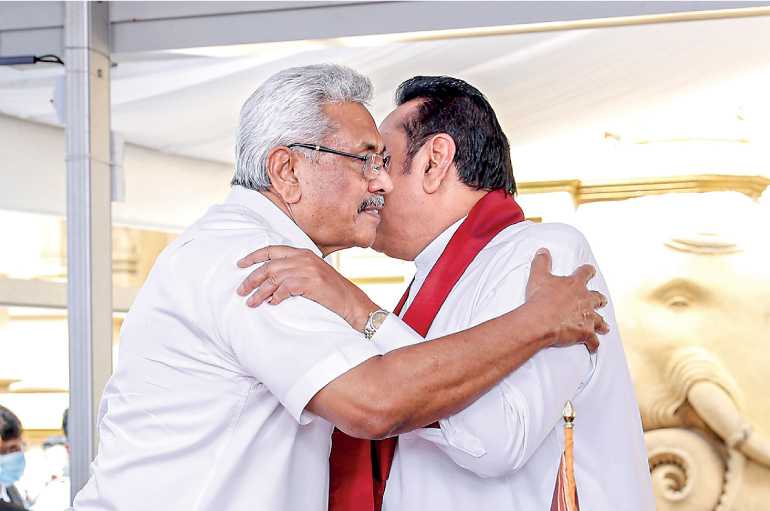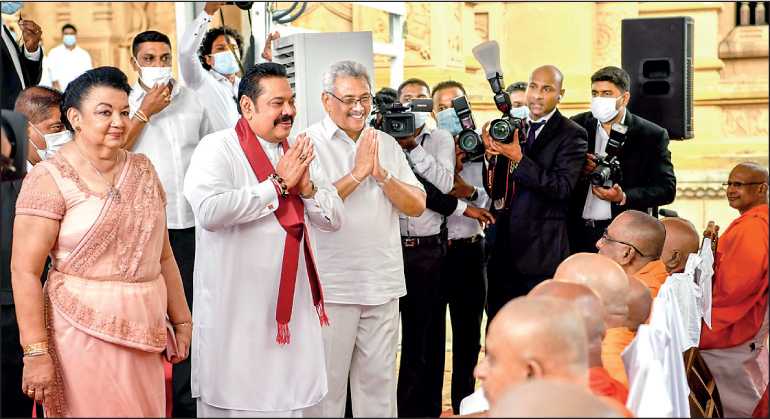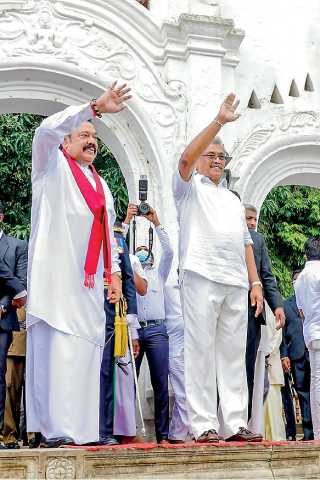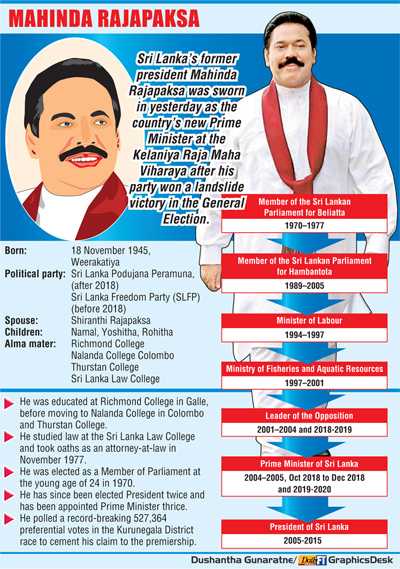Friday Apr 19, 2024
Friday Apr 19, 2024
Monday, 10 August 2020 02:20 - - {{hitsCtrl.values.hits}}

President Gotabaya Rajapaksa and Prime Minister Mahinda Rajapaksa hug each other after the swearing in ceremony of the latter yesterday

President Gotabaya Rajapaksa and Prime Minister Mahinda Rajapaksa wave at supporters gathered at the swearing in ceremony of the latter at the Kelaniya Raja Maha Viharaya
By Chandani Kirinde
To call the rise of the Sri Lanka Podujana Peramuna (SLPP) “meteoric” would be an understatement.
Within less than four years after its launch, the SLPP has usurped all its political rivals by winning a majority in Sri Lanka’s Parliament, having its candidate elected as the country’s President and taking control of the majority of local authorities in the country.
While all point to Basil Rajapaksa as the brains behind the outfit, the SLPP has relied on, and perfected by now, a time-tested winning formula made up of an unhealthy dose of Sinhala/Buddhist majoritarianism, monopolising “patriotism” and romanticising nepotism.
But however good a formula is, it needs a catalyst to get the desired result and in the case of the SLPP, the charisma of Mahinda Rajapaksa and his relatability to the masses made him the perfect catalyst to cement the party’s winning formula.
 |
| President Gotabaya Rajapaksa and Prime Minister Mahinda Rajapaksa greet the clergy at the swearing in ceremony of the latter at the Kelaniya Raja Maha Viharaya |
|
|
The SLPP was launched on 1 November 2016 as a political front mainly to counter the Sri Lanka Freedom Party (SLFP), the leadership of which was taken over arbitrarily by the then President Maithripala Sirisena.
Most political pundits dismissed it as an attempt by disgruntled elements within the Rajapaksa camp to retake power after being ousted in the 2015 Presidential and Parliamentary Elections but all that changed on 10 February 2018 when the party swept the Local Authorities Election, winning 231 of the 340 seats up for grabs.
Since then there has been no turning back for the SLPP, building a massive voter base. In the LA election, the SLPP won 4,941,952 votes, in November’s Presidential Election the party’s candidate Gotabaya Rajapaksa secured 6,924,255 votes, and at Wednesday’s Parliamentary Election, the SLPP won 6,853,693 votes.
The obvious comparison in a Sri Lankan context on the rise of a political party, within a short span of time, to take control of Government is the rise of the Sri Lanka Freedom Party (SLFP) in the early 1950s.
The SLFP was launched on 2 September 1951 by S.W.R.D. Bandaranaike, and in less than five years the party had captured power, routing the United National Party (UNP) in the General Election held in April 1956, winning 51 of the 95 seats in the House of Representatives (Parliament) and reducing the UNP to a mere eight seats.
Between then and 2020, the SLFP, in coalition with other left leaning parties, have held power in the country alternatively with the UNP, but the rise of the SLPP has killed off the SLFP and pushed the UNP down a rabbit hole from which it will take a long time to crawl out of.
Ironically, it was D.A. Rajapaksa, Mahinda Rajapaksa’s father, who stood shoulder to shoulder with Bandaranaike when he decided to break ranks with the powerful UNP and form the SLFP. The very party which became a power to be reckoned with in the country from 1956 onwards is now a spent force, the final nail in the coffin of which has been dealt by the party led by Mahinda Rajapaksa. In hindsight, the decision by Sirisena to take control of the SLFP was a blessing in disguise for the politically savvy Rajapaksa, who first entered Parliament winning a seat as the MP for Beliatta in 1970. After losing the 1977 General Election, he had to sit-out a long hiatus till 1989 to re-enter Parliament, after the Referendum of 1982 to extend the term of the 1977 Parliament put brakes on an earlier entry to the Legislature. 
Mahinda Rajapaksa, always the street fighter and the man of the masses, only needed time in Opposition to strategise his rise to the highest office in the land, becoming President in 2005 and again in 2010.
Since losing power in his shock defeat in 2015, instead of going into political wilderness quietly, he seized on the mass disillusionment among the people with the Yahapalanaya Government to launch the SLPP and within a short span of four years, placed it on a solid footing playing on the same “issues”, same sentiments and insecurities most Sri Lankan are still grappling with seven decades after independence from colonial rule. In “A History of Ceylon”, renewed historian K.M.de Silva writes that the reason the public embraced the SLFP with open arms in 1956 was the failure of the Government held by D.S. Senanayake and his left wing critics to understand the “Buddhists’ sense of outrage and indignation at what they regarded as the historic injustices suffered by their religion under Western rule”, and the lack of sympathy to the “religious, linguistic and cultural aspirations of the Buddhist activists”.
It was to this group with its “deep sense of grievance, its social and economic discontent, its resentment at being neglected by both the left and the UNP”, that the SLFP turned.
In 2020, the SLPP has drawn its strength from a vast majority of voters with a similar sense of grievance and discontent. With the line between left leaning and right leaning political forces in the country blurred by now, the SLPP has emerged victorious using its winning formula to perfection, which its main opponents too used but less efficiently.
Sri Lankan voters have been very generous towards the SLPP from its inception, but they are also an unforgiving and impatient lot, falling foul with even their most revered leaders. This is one fact that Mahinda Rajapaksa knows more than anyone else in this country given his fall from grace in 2015.
It takes little to disenchant Lankan voters and the SLPP, which is riding the waves with its resounding victory, will no doubt bear this in mind as it takes control of the Government for the next five years.